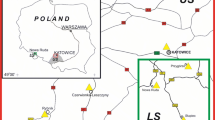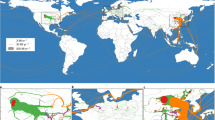Abstract
Spontaneous combustion and low-temperature oxidation of waste coal and other carbonaceous material at open-cut coal mines are potentially significant sources of greenhouse gas emissions. However, the magnitude of these emissions is largely unknown. In this study, emissions from spontaneous combustion and low-temperature oxidation were estimated for six Australian open-cut coal mines with annual coal production ranging from 1.7 to more than 16 Mt. Greenhouse emissions from all other sources at these mines were also estimated and compared to those from spontaneous combustion and low-temperature oxidation. In all cases, fugitive emission of methane was the largest source of greenhouse gas; however, in some mines, spontaneous combustion accounted for almost a third of all emissions. For one mine, it was estimated that emissions from spontaneous combustion were around 250,000 t CO2-e per annum. The contribution from low-temperature oxidation was generally less than about 1% of the total for all six mines. Estimating areas of spoil affected by spontaneous combustion by ground-based surveys was prone to under-report the area. Airborne infrared imaging appears to be a more reliable method.
Similar content being viewed by others
References
Attalla, M. I., Day, S. J., Lange, T., Lilley, W., & Morgan, S. (2008). NOx emissions from blasting operations in open-cut mining. Atmospheric Environment, 42, 7874–7883. doi:10.1016/j.atmosenv.2008.07.008.
Australian Department of Climate Change (2008a). National inventory report 2006 (revised, vol. 1, 219 pp.). The Australian Government submission to the UN framework convention on climate change. Canberra, Australia: Department of Climate Change. http://www.climatechange.gov.au/inventory/2006/pubs/inventory2006-nationalreportv1.pdf. Accessed 11 July 2008.
Australian Department of Climate Change (2008b). National greenhouse accounts (NGA) factors. Canberra, Australia: Department of Climate Change. http://www.climatechange.gov.au/workbook/pubs/workbook-feb2008.pdf. Accessed 22 July 2008.
Burrows, W. H., Hoffmann, M. B., Compton, J. F., Back, P. V., & Tait, L. J. (2000). Allometric relationships and community biomass estimates for some dominant eucalypts in central Queensland woodlands. Australian Journal of Botany, 48, 707–714. doi:10.1071/BT99066.
Burrows, W. H., Henry, B. K., Back, P. V., Hoffmann, M. B., Tait, L. J., Anderson, E. R., et al. (2002). Growth and carbon stock change in eucalypt woodlands in northeast Australia: Ecological and greenhouse sink implications. Global Change Biology, 8, 769–784. doi:10.1046/j.1365-2486.2002.00515.x.
Carras, J. N., Day, S. J., Szemes, F., Watson, J. A., & Williams, D. J. (2002). Airborne infrared thermography as a method for monitoring spontaneous combustion and greenhouse gas emissions. ACARP Project C9062 Final Report (41 pp.). Brisbane: Australian Coal Association.
Carras, J. N., Day, S. J., Saghafi, A., & Williams, D. J. (2009). Greenhouse gas emissions from low temperature oxidation and spontaneous combustion at open-cut coal mines in Australia. International Journal of Coal Geology. doi:10.1016/j.coal.2008.12.001.
Kuenzer, C., Zhang, J., Tetzlaff, A., van Dijk, P., Voight, S., Mehl, H., et al. (2007). Uncontrolled coal fires and their environmental impacts: Investigating two arid mining regions in north-central China. Applied Geography (Sevenoaks, England), 27, 42–62. doi:10.1016/j.apgeog.2006.09.007.
Leung, L. (2002). Coal mine greenhouse gas emissions measurement accuracy. ACARP Project 11003 Final Report (32 pp.). Brisbane: Australian Coal Association.
Saghafi, A., Roberts, D., Fry, R., Quintanar, A., Day, S., Lange, T., et al. (2008). Evaluating a Tier 3 method for estimating fugitive emissions from open cut coal mining. ACARP Project 15076 Final Report (104 pp.). Australian Coal Association, Brisbane.
Stracher, G. B., & Taylor, T. P. (2004). Coal fires burning out of control around the world: thermodynamic recipe for environmental catastrophe. International Journal of Coal Geology, 59, 7–17. doi:10.1016/j.coal.2003.03.002.
Williams, D. J., Carras, J. N., Mallett, C., Mark, M., Cooke, D., & Randall, C. (1998). Scoping study on the management and abatement of greenhouse gas emissions. ACARP Project C7050 Final Report (84 pp.). Brisbane: Australian Coal Association.
Author information
Authors and Affiliations
Corresponding author
Rights and permissions
About this article
Cite this article
Day, S.J., Carras, J.N., Fry, R. et al. Greenhouse gas emissions from Australian open-cut coal mines: contribution from spontaneous combustion and low-temperature oxidation. Environ Monit Assess 166, 529–541 (2010). https://doi.org/10.1007/s10661-009-1021-7
Received:
Accepted:
Published:
Issue Date:
DOI: https://doi.org/10.1007/s10661-009-1021-7




